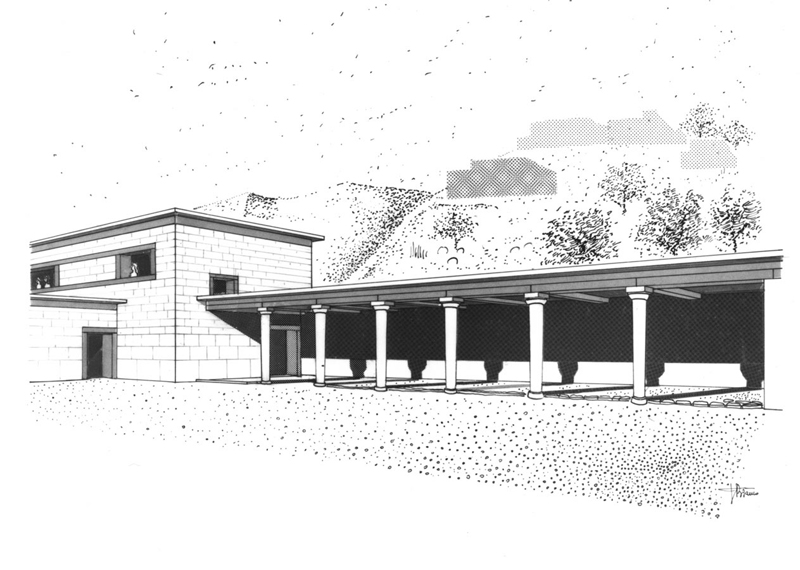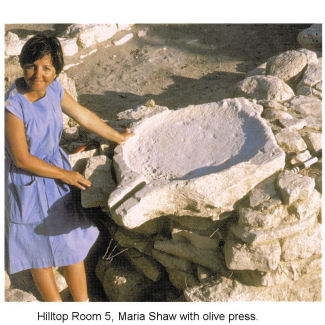About
History of Kommos
Kommos, a large Minoan and Greek site, lies on the shore of the Libyan Sea north of Matala in South-central Crete During the Minoan period (c. 1750 – 1250 B.C.) it featured a town of some 35,000 square meters.The town itself was set on a hillside and higher areas to the north To the south, on the flatter area bordering the shore, there was a succession of three enormous structures, two of which were palatial, with wings and a central court.The third appears to be six massive shipsheds which may have housed ships of the Cretan fleet during the winter, non-sailing months. These were the first Minoan shipsheds to be found, but others have since been discovered at the port of Knossos and at Gournia.Kommos’s position on the sea, with its wealth of materials brought from Cyprus, Egypt, Syria and elsewhere, lead one to the conclusion that it was the harbor-town or epineion of nearby Minoan Phaistos and Hagia Triada.During the Greek and Roman period (1025 B.C. – 250 A.D.) the southern area was used for religious rather than commercial purposes. Three successive temples, accompanied by many offerings, were built upon each other, all set upon the ruins of earlier Minoan buildings. Various structures were built around the temples, including four altars from the final period, when Zeus and Athena were worshipped.Together, the temples and the underlying Minoan palatial walls, represent an architectural assemblage unique on Crete, one that must be preserved intact. During the Early Roman period sand, drifting in from the shoreline, began to accumulate on the site, which had been abandoned. Eventually the entire site was covered by sand which in some places reached a depth of eight meters, especially on the south. The area lay deserted until 1976 when the University of Toronto initiated excavations that continued for 30 years. Now the effort is being made to deal with environmental problems (e.g. erosion and sand accumulation) and at the same time conserve and protect the complex’s well-preserved remains of civic and religious buildings, as well as those of the Minoan town.
Chart 1 Chronology of Ancient Kommos
This chronology is adapted from Joseph W Shaw’s Book, “KOMMOS: A Minoan Harbor Town and Greek Sanctuary In Southern Crete” (“KOMMOS” hereafter) which can be purchased on line or from your local book store, by special order.
The excavator of Knossos, Sir Arthur Evans, divided the post-Neolithic, “Minoan” period into three phases (Early, Middle, Late Minoan) with numerical subdivisions (e.g., Late Minoan III [LM III]) that can be further subdivided (e.g., LM IIIA). The sub-periods are roughly delineated by changes in ceramic form and decoration that can often be linked to architectural changes on sites. An alternative terminology refers to the emergence of the Minoan palaces (MM IB–MM II) and their renewal (from MM III–LM I) as Protopalatial and Neopalatial, respectively.
- 3500–2000 B.C. Late Neolithic-Early Minoan Periods. At Kommos, only sparse occupation.
- 2000–1700 B.C. Middle Minoan IA–II Periods, Protopalatial Period. The Kommos town spreads. The first large civic building (AA) is founded and later destroyed, perhaps by earthquake, at the end of the period.
- 1700–1425 B.C. Middle Minoan III–Late Minoan I Periods, Neopalatial Period. Kommos town expands. Building T is constructed at the beginning of the period, but gradually falls into disuse while life continues in the town.
- 1425–1375 B.C. Late Minoan II–IIIA Periods, Continued occupation. Destruction of Knossos in northern Crete at end of period.
- 1375–1200 B.C. Late Minoan IIIA2–IIIB Periods. A regional Mesara revival in LM IIIA2 brings about the construction of massive Building P, later abandoned along with the town.
- 1200–1020 B.C. Late Minoan IIIC–Subminoan Periods. The Kommos site lies unoccupied, but at the end of the period the fi rst Greek temple (A) is founded above Minoan Building T.
- 1020–600 B.C. Subminoan–Greek Geometric/Orientalizing Periods. Temple B is founded above Temple A around 800 B.C. Building Q is built later. After a period of intense use, the sanctuary is largely abandoned at end of period.
- 600–400 B.C. Archaic/Classical Periods. Limited use. An outdoor shrine with a single built altar (H) and a building (F) of uncertain use.
- 400–30 B.C. Late Classical and Hellenistic Periods. Rejuvenation of the Greek sanctuary with the founding of Temple C above Temple B, followed by the building of numerous other structures (A, B, D, E, W), and altars (C,L,M).
- 30 B.C.–A.D. 150 Roman. Limited use followed by desertion of the site.
Major findings from the Kommos Excavation
The excavation of the Minoan harbor-side town of Kommos, by Professors Joseph and Maria Shaw, in association with the University of Toronto and under the auspices of the A.S.C.S.A., began in earnest in 1976, following protracted negotiations to obtain the site and permits as outlined in KOMMOS. The excavations were immediately fruitful. Ancient walls, a Rhyton and a Snake Tube were uncovered in the first days.Only walls and foundations of the Minoan buildings remained, with evidence of extensive rebuilding in some cases. In time, it became clear that there were three areas of ancient occupation. The Hilltop and Hillside areas were primarily residential with integrated work areas whereas the Southern area was the civic center of the site.


Progress towards a cause
A water line was brought down by the local municipality of Pitsidia and Tamarask trees were encourage to grow just inside the fence line further augmenting the palm frond-wind-barrier (1998 Plan Section II). Clairy Palyvou, a Conservation Architect and Educator, was retained to develop scarp and archaic wall stabilization plans (1998 Plan Section III) that were carried out by conservation contractor Costas Nikakis.
The ‘North’ Stoa, along the north side of the Central Court, like that facing it on the south, was supported by six columns. It sheltered members of groups that used the court for communal displays and other activities. Its back wall and much of its floor were decorated with colored and spiral frescos. Because of later building during both Minoan and Greek periods, much of its structure is masked by later walls.
Concern for the Future
In 2005 James Stratis revisited the site June-July and produced a Resurvey and Plan Update. The updated report with the original site conservation and development plan was utilized to garner approval of the local governments and by the architect and educator Clairy Palyvou to seek regulatory approvals.
Plans are made
Professor Palyvou was once again contracted in June, 2006 to produce roof shelter designs to protect the fragile pottery kiln within the stoa and the Greek temple sanctuary area. Palyvou worked in partnership with Sonia Mavrommatti, an Athens based conservation architect/ engineer, to produce design development plans, specifications and budget. These were finalized in January 2007. Excerpts are published in this web site through a Flickr link.
The future is now
It is time for a new chapter of stewardship, for this culturally significant and once sacred place to multiple civilizations. In early 2007, the non-profit organization, Kommos Conservancy was established to seek funding and to further implement the proposed Conservation of the site and provide Interpretation and Development for Visitation/Education. Ultimately a maintenance endowment will need to be established, as the Greek government is unable to meet all the needs associated with their stunning and overwhelming historical legacy.
For information on how you can contribute, click here.

